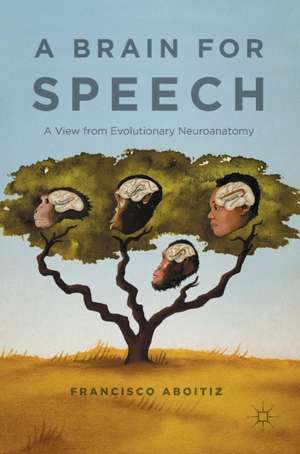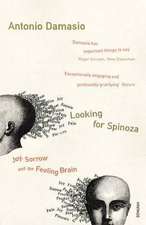A Brain for Speech: A View from Evolutionary Neuroanatomy
Autor Francisco Aboitizen Limba Engleză Hardback – 26 iul 2017
This book discusses evolution of the human brain, the origin of speech and language. It covers past and present perspectives on the contentious issue of the acquisition of the language capacity. Divided into two parts, this insightful work covers several characteristics of the human brain including the language-specific network, the size of the human brain, its lateralization of functions and interhemispheric integration, in particular the phonological loop. Aboitiz argues that it is the phonological loop that allowed us to increase our vocal memory capacity and to generate a shared semantic space that gave rise to modern language. The second part examines the neuroanatomy of the monkey brain, vocal learning birds like parrots, emergent evidence of vocal learning capacities in mammals, mirror neurons, and the ecological and social context in which speech evolved in our early ancestors. This book's interdisciplinary topic will appeal to scholars of psychology, neuroscience, linguistics, biology and history.
Preț: 957.13 lei
Preț vechi: 1167.23 lei
-18% Nou
Puncte Express: 1436
Preț estimativ în valută:
183.14€ • 191.73$ • 151.54£
183.14€ • 191.73$ • 151.54£
Carte tipărită la comandă
Livrare economică 07-21 aprilie
Preluare comenzi: 021 569.72.76
Specificații
ISBN-13: 9781137540591
ISBN-10: 1137540591
Pagini: 320
Ilustrații: XXIV, 505 p. 22 illus.
Dimensiuni: 148 x 210 x 36 mm
Greutate: 0.78 kg
Ediția:2017
Editura: Palgrave Macmillan UK
Colecția Palgrave Macmillan
Locul publicării:London, United Kingdom
ISBN-10: 1137540591
Pagini: 320
Ilustrații: XXIV, 505 p. 22 illus.
Dimensiuni: 148 x 210 x 36 mm
Greutate: 0.78 kg
Ediția:2017
Editura: Palgrave Macmillan UK
Colecția Palgrave Macmillan
Locul publicării:London, United Kingdom
Cuprins
Introduction: The beginning of words.- 1. Pandora’s box.- 2. A matter of size.- 3. Broken symmetry.- 4. Bridging hemispheres.- 5. A loop for speech.- 6. Monkey brain, human brain.- 7. Grasping mirrors.- 8. Of birds and men.- 9. Talking heads.- 10. Taming ourselves.- Epilogue.
Recenzii
“This book presents an ambitious combination of evolution and neuroscience applied to language development. … A curated bibliography and subject/author indexes round out the scholarly apparatus; overall, a compelling exploration that merges psychology, neurology, linguistics, and evolutionary biology. … Recommended. Graduate students, researchers, faculty, and professionals.” (J. A. Mather, Choice, Vol. 56 (1), September, 2018)
Notă biografică
Francisco Aboitiz is Professor of the Psychiatry Department at the Medical School, and Director of the Interdisciplinary Neuroscience Center at the Pontificia Universidad Católica de Chile. He has published more than 100 scientific papers on evolution, neuroscience and neuropsychiatry.
Textul de pe ultima copertă
This book discusses evolution of the human brain, the origin of speech and language. It covers past and present perspectives on the contentious issue of the acquisition of the language capacity. Divided into two parts, this insightful work covers several characteristics of the human brain including the language-specific network, the size of the human brain, its lateralization of functions and interhemispheric integration, in particular the phonological loop. Aboitiz argues that it is the phonological loop that allowed us to increase our vocal memory capacity and to generate a shared semantic space that gave rise to modern language. The second part examines the neuroanatomy of the monkey brain, vocal learning birds like parrots, emergent evidence of vocal learning capacities in mammals, mirror neurons, and the ecological and social context in which speech evolved in our early ancestors. This book's interdisciplinary topic will appeal to scholars of psychology, neuroscience, linguistics,biology and history.
Caracteristici
Introduces a revolutionary hypothesis on the origin of speech Delves deep into the evolution of the brain Provides a neuroanatomical perspective on language














